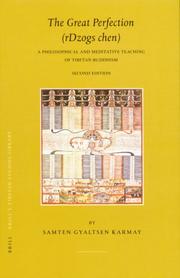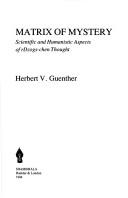| Listing 1 - 10 of 11 | << page >> |
Sort by
|
Book
ISBN: 2020629283 Year: 2005 Publisher: Paris : Seuil,
Abstract | Keywords | Export | Availability | Bookmark
 Loading...
Loading...Choose an application
- Reference Manager
- EndNote
- RefWorks (Direct export to RefWorks)
Rdzogs-chen --- Buddhism --- Dzogchen (Bön) --- Bouddhisme --- Bon (Tibetan religion)
Book
ISBN: 9782710329879 2710329875 Year: 2008 Publisher: Paris : La Table Ronde,
Abstract | Keywords | Export | Availability | Bookmark
 Loading...
Loading...Choose an application
- Reference Manager
- EndNote
- RefWorks (Direct export to RefWorks)
Buddhism --- Rdzogs-chen --- Bouddhisme --- Dzogchen (Bön) --- Bon (Tibetan religion) --- Klon-chen-pa Dri-med-'od-zer, --- Dzogchen (Bön) --- Klong-chen-pa Dri-med-ʼod-zer,
Book
ISBN: 9782960345919 2960345916 2960345916 Year: 2024 Publisher: Bruxelles: Vues de l'esprit,
Abstract | Keywords | Export | Availability | Bookmark
 Loading...
Loading...Choose an application
- Reference Manager
- EndNote
- RefWorks (Direct export to RefWorks)
Le dzogchen, tradition tibétaine la plus secrète, offre à voir de rares cas d’un phénomène extraordinaire. À la mort de pratiquants particulièrement accomplis, leur corps physique se dissout en lumière, ce qu’on appelle le corps arc-en-ciel. Étudiant un cas récent, Francis Tiso fait le rapprochement avec la résurrection de Jésus-Christ. Le dzogchen ancien devrait-il quelque chose aux enseignements contemplatifs du christianisme syriaque, diffusé le long des Routes de la soie jusqu’en Chine dès le VIIe siècle ?Enquête ethnographique, découvertes archéologiques, anthropologie et théologie sont mobilisées pour explorer l’hypothèse vertigineuse de rencontres et d’échanges autour de pratiques visionnaires entre chrétiens et bouddhistes, manichéens, musulmans, taoïstes et hindous dans des oasis d’Asie centrale, d’où serait née la tradition dzogchen. Ce livre unique, foisonnant et érudit, bouleverse les cloisonnements traditionnels et ouvre de nouvelles perspectives, tant sur l’histoire des religions qu’à propos des pratiques spirituelles les plus élevées. La mort n’est peut-être pas la fin de toutes choses, mais la lumière qui revient à la lumière.
Résurrection. --- Dzogchen. --- Christianisme --- Laya-yoga. --- Réincarnation. --- Corps humain --- Corps (philosophie) --- Philosophie. --- Religion.
Book
ISBN: 9782351180716 Year: 2012 Publisher: Paris Editions Almora
Abstract | Keywords | Export | Availability | Bookmark
 Loading...
Loading...Choose an application
- Reference Manager
- EndNote
- RefWorks (Direct export to RefWorks)
Dzogchen --- le vol du Garouda --- Kuntou Zangpao --- la sagesse souveraine --- l'extraordinaire réalité de la sagesse souveraine --- bouddhisme tibétain
Book
ISBN: 9781476777726 Year: 2014 Publisher: New York, NY Simon & Schuster
Abstract | Keywords | Export | Availability | Bookmark
 Loading...
Loading...Choose an application
- Reference Manager
- EndNote
- RefWorks (Direct export to RefWorks)
spirituality --- religion --- mindfulness --- enlightenment --- conscious and unconscious processing in the brain --- the self --- meditation --- Dzogchen --- gurus --- death --- drugs --- the spiritual uses of pharmacology

ISBN: 1281926027 9786611926021 9047419782 9789047419785 9789004151420 9004151427 9781281926029 661192602X Year: 2007 Volume: 11 Publisher: Leiden Boston Brill
Abstract | Keywords | Export | Availability | Bookmark
 Loading...
Loading...Choose an application
- Reference Manager
- EndNote
- RefWorks (Direct export to RefWorks)
The Great Perfection (rDzogs chen in Tibetan) is a philosophical and meditative teaching. Its inception is attributed to Vairocana, one of the first seven Tibetan Buddhist monks ordained at Samye in the eight century A.D. The doctrine is regarded among Buddhists as the core of the teachings adhered to by the Nyingmapa school whilst similarly it is held to be the fundamental teaching among the Bonpos, the non-Buddhist school in Tibet. After a historical introduction to Tibetan Buddhism and the Bon, the author deals with the legends of Vairocana (Part I), analysing early documents containing essential elements of the doctrine and comparing them with the Ch'an tradition. He goes on to explore in detail the development of the doctrine in the tenth and eleventh centuries A.D. (Part II). The Tantric doctrines that play an important role are dealt with, as are the rDzogs chen theories in relation to the other major Buddhist doctrines. Different trends in the rDzogs chen tradition are described in Part III. The author has drawn his sources mainly from early unpublished documents which throw light on the origins and development, at the same time also using a variety of sources which enabled him to explicate the crucial position which the doctrine occupies in Tibetan religions.
Rdzogs-chen --- Rdzogs-chen. --- Rdzogs-chen (Bonpo) --- Spiritual life --- Atiyoga --- Dzogchen --- Dzogschen --- Rdsogs-chen --- Rdzogs-chen (Rñiṅ-ma-pa) --- Rdzogs-pa-chen-pa --- Bon (Tibetan religion) --- Rnying-ma-pa (Sect) --- Buddhism --- Rdzogs-chen - Bon (Tibetan religion)

ISBN: 0877732914 9780394540733 9780877732914 0394540735 Year: 1984 Publisher: Boulder Shambhala
Abstract | Keywords | Export | Availability | Bookmark
 Loading...
Loading...Choose an application
- Reference Manager
- EndNote
- RefWorks (Direct export to RefWorks)
World-renowned Buddhist scholar Herbert V. Guenther here offers the first comprehensive study of the rDzogs-chen or Ati tradition of the Nyingma school of Tibetan Buddhism. Matrix of Mystery explores man's ability to preserve as well as transmit essential insights into the structure of reality.Utilizing a key root Buddhist scripture, the Guhyagarbha ("Matrix of Mystery"), along with dozens of commentarial Tibetan textual sources, Guenther presents the most profound teachings of the Buddhist tradition, which represent the culmination of religious thought and practice in Tibet. In relating these teachings in modern scientific and humanistic perspectives, he demonstrates how, in many cases, the traditional religious and modern secular perspectives on the nature of reality interface.Professor Guenther discusses the mandala and the deities that reside therein; the organizing principles of body, speech, mind, quality, and action, the three bodies of the buddha (trikaya); the inseparability of prajna and skillful means; and the complex field of Buddhist iconography. Throughout, quotations from numerous Tibetan sources are used to illustrate various teachings. His book will appeal to any serious student of Tibetan Buddhism.
Rdzogs-chen (Rñiṅ-ma-pa) --- Rñiṅ-ma-pa (Sect) --- Ningmapa (Sect) --- Nying-ma (Sect) --- Nying-ma-pa (Sect) --- Buddhist sects --- Atiyoga --- Dzogchen --- Dzogschen --- Rdsogs-chen --- Rdzogs-chen --- Rdzogs-pa-chen-pa --- Spiritual life --- Doctrines --- Rnying-ma-pa (Sect) --- Buddhism
Book
ISBN: 9780231556187 Year: 2023 Publisher: New York : Columbia University Press,
Abstract | Keywords | Export | Availability | Bookmark
 Loading...
Loading...Choose an application
- Reference Manager
- EndNote
- RefWorks (Direct export to RefWorks)
Ritual manuals are among the most common and most personal forms of Buddhist literature. Since at least the late fifth century, individual practitioners—including monks, nuns, teachers, disciples, and laypeople—have kept texts describing how to perform the daily rites. These manuals represent an intimate counterpart to the canonical sutras and the tantras, speaking to the lived experience of Buddhist practice.Conjuring the Buddha offers a history of early tantric Buddhist ritual through the lens of the Tibetan manuscripts discovered near Dunhuang on the ancient Silk Road. Jacob P. Dalton argues that the spread of ritual manuals offered Buddhists an extracanonical literary form through which to engage with their tradition in new and locally specific ways. He suggests that ritual manuals were the literary precursors to the tantras, crucial to the emergence of esoteric Buddhism. Examining a series of ninth- and tenth-century tantric manuals from Dunhuang, Dalton uncovers lost moments in the development of rituals such as consecration, possession, sexual yoga, the Great Perfection, and the subtle body practices of the winds and channels. He also traces the use of poetic language in ritual manuals, showing how at pivotal moments, metaphor, simile, rhythm, and rhyme were deployed to evoke carefully sculpted affective experiences. Offering an unprecedented glimpse into the personal practice of early tantric Buddhists, Conjuring the Buddha provides new insight into the origins and development of the tantric tradition.
Tantric Buddhism --- RELIGION / Buddhism / Tibetan. --- History. --- Rituals --- Dunhuang. --- Dzogchen. --- Tibetan Buddhism. --- consecration. --- esoteric Buddhism. --- possession. --- religious studies. --- rites and rituals. --- ritual manuals. --- sexual yoga. --- tantra. --- the Great Perfection. --- Buddhism, Tantric --- Buddhist tantrism --- Esoteric Buddhism --- Mantrayāna Buddhism --- Mikkyō --- Tantrism, Buddhist --- Vajrayāna Buddhism --- Buddhism --- Mahayana Buddhism
Book
ISBN: 900453637X 9004534229 Year: 2023 Publisher: BRILL
Abstract | Keywords | Export | Availability | Bookmark
 Loading...
Loading...Choose an application
- Reference Manager
- EndNote
- RefWorks (Direct export to RefWorks)
"The notion of effortlessness is central to the self-understanding of the Tibetan contemplative tradition known as Dzogchen. This book explores this key notion from a variety of perspectives, highlighting the distinctive role it plays in the Dzogchen approach's doctrinal architecture and meditative programme. The book's focus is on the early development of the Dzogchen tradition, especially as codified in a set of hitherto unstudied commentaries by the 10th-century scholar and meditation master Nubchen Sangye Yeshe. A full annotated translation of the commentaries is provided, along with an edition of the Tibetan texts on facing pages"--
Rnying-ma-pa (Sect) --- Rdzogs-chen. --- Doctrines. --- Sangs-rgyas-ye-shes, --- Atiyoga --- Dzogchen --- Dzogschen --- Rdsogs-chen --- Rdzogs-chen --- Rdzogs-chen (Rñiṅ-ma-pa) --- Rdzogs-pa-chen-pa --- Spiritual life --- Buddhism --- Saṅs-rgyas-ye-śes, --- Gnubs-chen Saṅs-rgyas-ye-śes --- Nubchen Sangye Yeshe --- Sangye Yeshe, Nubchen --- Yeshe, Nubchen Sangye
Book
ISBN: 9781543957778 Year: 2019 Publisher: Portland, Maine Walk Away Publishing
Abstract | Keywords | Export | Availability | Bookmark
 Loading...
Loading...Choose an application
- Reference Manager
- EndNote
- RefWorks (Direct export to RefWorks)
lamaism --- the Tulkus --- deities --- demons --- sexual abuse --- Trungpa --- Hollywood --- the middle class --- Tibetan Tantra --- Shambhala --- Bateson --- psychology --- Guru --- worship --- Lifton --- Tibetan Buddhism --- guru yoga --- cult technique --- the royal family of Trungpa --- the Dakinis --- spiritualized feminism --- Dharma --- Crestone, Colorado --- lunacy --- the Green New Deal --- mindfulness meditation --- cult members --- Dzogchen
| Listing 1 - 10 of 11 | << page >> |
Sort by
|

 Search
Search Feedback
Feedback About UniCat
About UniCat  Help
Help News
News